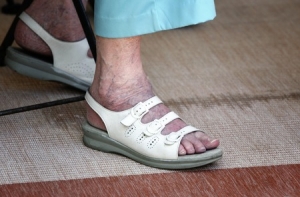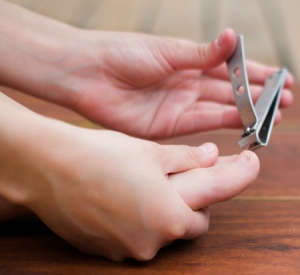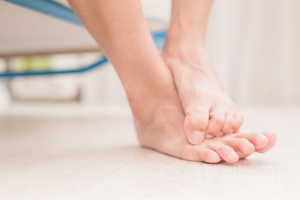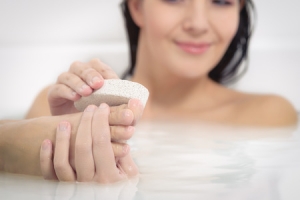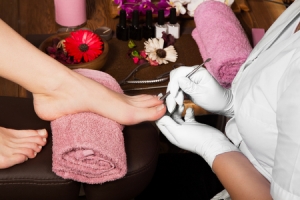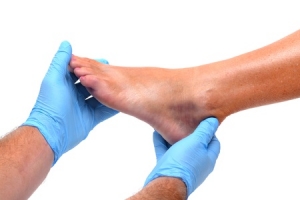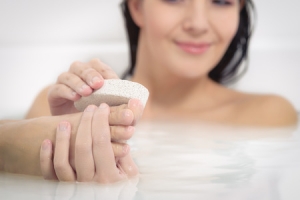Connect With Us
Blogs
Displaying items by tag: athlete's foot
5 Best Practices for Older Patients
At Superior Foot & Ankle Care Center, we take care of the feet of patients of all ages. This month—Older Americans Month—we want to offer some information for taking good care of senior feet. While it’s true that some conditions are more likely to occur with age, there are still many ways to prevent disabling problems and ensure that your golden years remain active. Below are 5 tips for better foot health for older patients:
- Keep feet clean and dry. Wash feet every day with warm soapy water and dry completely. If you tend to sweat excessively, use an anti-fungal powder each morning and change your socks as soon as you notice that they feel damp. This will go a long way in preventing athlete’s foot and other fungal infections.
- Inspect your feet weekly. Look for changes in shape, color of skin and toenails, lumps or growths, rashes, bruising and swelling. Report anything that seems abnormal to our podiatrists, Victoria M. Foley or Dr. Constance Ornelas so they can evaluate your feet and determine if a condition exists that needs treatment.
- Maintain good circulation. This means not smoking and avoiding standing or sitting—especially with your legs crossed– in one position for a prolonged period of time. Don’t wear tight hose and socks.
- Move it along. Exercise will also help with circulation. In addition, it will keep feet and ankles flexible, maintain good range of motion and control weight.
- Buy good shoes. Roomy toe boxes, soft and flexible materials and a proper fit will help you avoid many common foot problems. Forgo heels that are higher than two inches and rotate your shoes from day to day.
Don’t put off making an appointment if you are experiencing foot pain or discomfort. This leads to an increase risk of falls and the chance that your condition will worsen and require more invasive treatment. Contact our Long Beach office today for an appointment by calling: (562) 420-9800.
10 Simple Steps to Healthier Feet
At Superior Foot & Ankle Care Center we want patients to know that being proactive about the health of your feet and ankles doesn’t have to be difficult or time consuming. April is National Foot Health Awareness Month and in its honor, we are providing these easy suggestions for taking care of your feet:
- Wash your feet every day with soap and warm water.
- Keep feet dry—change your socks if you sweat excessively. Dry between your toes after you shower. Dry feet are less likely to develop athlete’s foot.
- Don’t share shoes, socks, nail clippers, towels or other items that touch someone else’s feet.
- Inspect your feet regularly. Look for signs of foot disorders: swelling, redness, rashes, growths, lumps, discoloration of toenails and any cuts or wounds that are slow to heal.
- Don’t delay seeking treatment for foot and ankle pain. Most podiatric conditions will get worse the longer they go untreated. If you are experiencing foot pain or discomfort, make an appointment with our podiatrists, Victoria M. Foley or Dr. Constance Ornelas to get your condition evaluated as soon as possible.
- Get your foot measured professionally. Foot size can change during pregnancy and as you age. The majority of patients are wearing shoes that are too small for their feet.
- Wear shoes with good arch support. Many cases of heel pain and plantar fasciitis are caused by footwear that allows your arch to flatten, which in turn puts pressure on your heel.
- Stretch your feet. Flexing your feet, wiggling your toes and rotating your ankles all help keep feet flexible and promote good range of motion.
- Maintain a healthy weight. Many foot disorders are caused or made worse by being overweight.
- Apply sunscreen to your feet when they will be exposed—this means when you’re wearing sandals and open shoes as well as when you’re spending a day at the beach or pool.
Following these small steps will have a big impact on the health of your feet. To learn more about how to be proactive in the care of your feet, contact our Long Beach office by calling: (562) 420-9800.
5 Foot Symptoms and What They Mean
At Superior Foot & Ankle Care Center, we urge all of our patients to inspect their feet regularly and report any unusual changes to our podiatrists, Dr. Victoria Foley or Dr. Constance Ornelas. Sometimes, however, we find out that patients put off making an appointment at our Long Beach office because the change they’ve noticed just doesn’t seem that serious. Small changes can mean big foot problems, and your feet can also act an “early warning system” for diseases that can affect your whole body. Below are some changes in your feet and what they may mean:
- Red skin. Although short-term redness of the feet could just be due to temperature change or an allergic reaction to your laundry detergent, consistent redness can mean something more serious. Infections, such as athlete’s foot, can start with redness of the skin and an itchy rash. Consistently red or inflamed feet can also be a sign of the autoimmune disease of lupus.
- Black toenail. Unless you’ve recently stubbed your toe or you’re a runner, a black or discolored toenail is characteristic of a fungal infection. These may not be painful initially but will continue to progress and are contagious if not treated.
- There are several diseases which can cause excess fluid buildup (also called edema) in your legs and feet. These include: kidney or liver failure, heart disease and diabetes. If you are pregnant, a certain amount of swelling is normal but if in the last trimester of your pregnancy you experience sudden or excessive swelling, it may be a sign of a preeclampsia, a serious condition that requires immediate treatment.
- Cold feet. If your feet are always cold, regardless of the season or temperature, it can be an indicator of poor circulation. There are several possible causes for this, including diabetes, anemia and an underactive thyroid.
- Everyone gets a foot cramp occasionally, but if you are getting them regularly, it’s something to get checked out. In some cases, it may simply be a case of dehydration or a lack of certain minerals in your diet like magnesium, potassium or calcium. On the other end of the spectrum, however, ongoing foot cramps can be an indicator of nerve damage.
If you notice anything different about your feet or ankles—even if the changes are not painful or dramatic—contact us as soon as possible at: (562) 420-9800.
How to Have Healthy Feet
January is a good time for starting new habits, and we at Superior Foot & Ankle Care Center would like to urge patients to make this the year that you commit to better care of your feet. We believe in educating our patients to be proactive about the health of their feet. There are many ways that you can reduce your risk of injury and foot disorders and improve your podiatric health. Below are some suggestions:
- Wash your feet every day with mild soap and warm water. Dry them thoroughly, with particular attention to the area between the toes. This will significantly reduce the risk of athlete’s foot.
- Don’t walk barefoot. Out in public, walking without shoes increase your risk of coming in contact with a fungal infection. Even at home, you can protect your feet from stepping on sharp objects by keeping them covered.
- Get in the habit of inspecting your feet on a regular basis. The best outcomes for foot disorders occur when they are treated in their earliest stages. Being vigilant about reporting changes in skin or nail color, swelling, bumps or growths, bruising and cuts that don’t seem to be healing to our podiatrists, Victoria Foley or Dr. Constance Ornelas, can save you from prolonged and invasive treatments.
- Making wise shoe choices. Did you know that the single most significant step you can take to improve the health of your feet is choosing good shoes? Styles with roomy toe boxes that don’t constrict your toes, adequate arch support and laces for a firm fit can reduce the risk of falls, joint conditions, and toe deformities. In addition, getting away from wearing high heels can prevent neuromas and lessen the chances of bunions and several other podiatric problems.
- Apply sunscreen, not just on beach days but any days when the bare skin of your feet will be exposed in open sandals or shoes to the sun. The skin on your feet is just as susceptible to skin cancer as the skin on the rest of your body.
- Take care of toenails. Keep your nails trimmed straight across and not too short to prevent ingrown toenails from developing.
Better foot care needn’t be complicated or time-consuming. A few simple changes in your daily regimen can make a world of difference. If you have questions regarding the care of your feet, contact our Long Beach office today by calling: (562) 420-9800.
Resolve to Get in Shape—Safely
Is starting a new fitness plan one of your New Year’s resolutions? At Superior Foot & Ankle Care Center we applaud this initiative, but also add a word of caution. We see too many patients who fail to take the necessary steps to ensure that their new fitness plan is safe. Prevent injuries and get your healthy resolution off to a smart start by taking into consideration the following.
Your Current Condition—do you suffer from any chronic foot or ankle disorders such as flat feet, plantar fasciitis or hammertoes? Our podiatrists, Dr. Victoria Foley or Dr. Constance Ornelas, can help you determine the best type of exercise and footwear to accommodate an existing podiatric condition. In some cases, special padding or even a custom orthotic device may be prescribed to make exercise more comfortable.
Long-term Goals—in order to determine the type of exercise to do, you need to know what your goals are. Do you want to lose weight? Have more strength and endurance? Improve flexibility and balance? Your general physician and exercise professionals can help match your goals to fitness activities and sports that will best achieve them.
Gear—in our opinion, your footwear is the most important piece of equipment for a new fitness program. Be sure that you get the right shoes for your sport and that they fit properly. If the foot doctor has recommended an orthotic, be sure it fits in your sports shoes. Look for socks that are not too bulky and ones that wick moisture away from your skin to prevent athlete’s foot and fungal infections.
Now you’re ready to begin. Start slow and gradually increase the degree of difficulty of your work out. If your feet or ankles hurt from your new exercise plan, contact our Long Beach office for an appointment by calling: (562) 420-9800.
Do’s and Don’ts for Better Foot Health
At Superior Foot & Ankle Care Center we want to encourage our patients to be proactive in the health of their feet. There are many ways that you can help prevent foot and ankle disorders.
Below are some basic foot care tips:
- Practice good podiatric hygiene. Wash your feet daily with soap and warm water. Drying feet completely, especially between the toes will help prevent athlete’s foot and other fungal infections.
- Don’t walk barefoot. Even in the comfort of your own home going barefoot increases the risk of puncture wounds from stepping on a sharp object hiding in the carpet or stubbing your toe or foot. In public places, walking with bare feet is an invitation for contagious podiatric conditions such as fungal toenails and
- Always use sunscreen on your feet when you are outside, and feet are exposed. This goes for days when you are out walking in open sandals as well as when you are at the beach or pool.
- Take care of toenails. Keeping toenails trimmed straight across (never with curved edges) and not too short reduces the risk of getting an ingrown toenail.
- Examine your feet periodically. Look for changes in nail or skin color, bruising, swelling, bumps, rashes and redness. Unusual changes can be a sign of a foot problem. If you notice anything concerning, contact our Long Beach office for an Our podiatrists, Dr. Victoria Foley or Dr. Constance Ornelas, will examine your feet and determine if a problem exists, that requires treatment.
- Don’t attempt to treat yourself. “Bathroom surgery” conducted by patients trying to shave corns, or calluses, remove warts or ingrown nails can lead to severe injury and infection. The podiatrist best handles those tasks.
- When in pain, seek treatment. Ignoring foot pain will usually result in condition getting worse. Don’t delay, contact us by calling: (562) 420-9800.
5 Foot Friendly Vacation Tips
At Superior Foot & Ankle Care Center we’ve heard horror stories of summer vacations that patients never got to enjoy because they were sidelined by a foot problem early on in their trip. We’d like to help prevent podiatric mishaps when traveling and so we are offering these 4 tips for safer summer vacations:
- Wear comfy shoes on travel days. Whether you’re flying or taking a long road trip, you’ll want to start (and end) your trip with a comfortable pair of shoes, preferably ones with low heels and roomy toe boxes. Travel days can be strenuous—loading luggage, running to catch a flight, getting in and out of the car, are all best done in a pair of shoes that won’t hurt your feet or cause you to trip or fall. You will also want dependable shoes for walking and sports activities—save the heels and sandals for dinner out.
- Wear water shoes at the beach or lake. If there’s water in your vacation plans be sure to pack water shoes. Rocks, nails, glass, broken shells and washed up jellyfish and insects can be hidden in sand and mud and you can protect your feet from puncture wounds, cuts and stings by keeping them covered. Another good reason for water shoes (and this is true at a resort pool too) is that they prevent your feet from coming in contact with fungi and bacteria that lurk in warm, moist, public places. Nobody wants to bring home a case of athlete’s foot!
- Lather on the sunscreen. If the sun can get to your feet, your feet can end up sunburned. Badly burned feet can mean spending precious vacation days unable to walk. Apply sunscreen to the tops and bottoms of your feet when at the beach or pool. For sightseeing or shopping trips, if you’ll be wearing sandals put sunscreen on first, then your shoes.
- Drink lots of water. Edema, or swelling of the feet and ankles, can make walking painful. Staying hydrated helps to get rid of excess fluid and decreases swelling. Plus, it’s good for the rest of your body too!
- Add a few items to your pack list. They won’t take up much space but moleskin, some bandages and antibiotic ointment, extra socks and foot powder can make your days more comfortable.
If your summer vacation leaves you with any unwanted souvenirs such as an ankle injury, an unexplained rash or foot pain, contact our Long Beach office as soon as you return by calling: (562) 420-9800. Our podiatrists, Dr. Victoria Foley or Dr. Constance Omelas will help determine the cause of the problem and prescribe the right treatment to get you back to basking in the afterglow of your vacation.
Beware of the Health Risks Involved with Pedicures
A pedicure at a professional salon is a relaxing treat that leaves nails looking pretty in sandals and open shoes. A fungal nail infection or a case of athlete’s foot, however, is not such a pleasant experience and one that we often see at Superior Foot & Ankle Care Center, as a result of poor sanitary practices at a salon. We want our patients to enjoy this “me time” activity safely. Below are some do’s and don’ts for ensuring you get a pedicure that will not harm your feet.
Do: Check out a salon you are considering for a pedicure before committing to an appointment. Visit first and observe the overall condition of the salon. Reputable salons are licensed and that certification from the state health or cosmetology department should be clearly displayed. Cleanliness should be a priority for the entire establishment. If restrooms are not clean, the floor is unswept, window sills are dusty or the cosmetologists themselves don’t have clean hands and nails, take the hint and go someplace else.
Don’t: use a whirlpool foot bath that has not been sanitized after the client before you. Some salons now have plastic inserts that can be thrown away after each customer.
Do: bring your own pedicure tools—clippers, files etc. Ditto for flip flops which should be worn at all times in the salon. If you do need to use the salon’s tools be sure that they come out of individually wrapped packages or are sanitized properly in a machine or with sanitizing solution.
Don’t: allow the nail technician to use razors to remove calluses or dead skin on your feet. This can create a cut that can lead to an infection.
Don’t: shave your legs right before your pedicure appointment. Better that you have hairy legs and avoid bacteria entering the skin through the tiny cuts caused by shaving.
Do: Make an appointment at our Long Beach office by calling: (562) 420-9800 if you do notice any signs of fungal infection, such as itchy, red patches on the skin of your feet or between your toes or nails that are getting thick, discolored or are starting to peel and crumble around the edges. Infections will not clear up on their own and can spread if left untreated. Our podiatrists, Dr. Victoria Foley and Dr. Constance Omelas will examine your feet and nails and prescribe the correct treatment if an infection has occurred.
Protecting Yourself with PAD
Peripheral arterial disease (or PAD) often affects patients that have diabetes. At Superior Foot & Ankle Care Center we always caution these patients to take extra care with their feet due to the serious one-two punch these diseases can deliver. PAD is a disease that results in poor circulation. Good blood flow is necessary for healing. Patients with diabetes often experience neuropathy or loss of sensation in their feet and toes. This means it can be difficult to perceive pain, heat or even itchy rashes—all of which may signal a situation that would result in an open sore or wound. Add PAD to that and you could end up with an ulcer or wound on your foot that will not heal. This, in turn, can lead to a dangerous infection, and, in the worst case scenario, possible amputation.
Simple Precautions
If you have diabetes you should already be on a regular schedule of checkups with our podiatrists, Dr. Victoria Foley and Dr. Constance Omelas in order to carefully monitor your condition. The foot doctor will also look for signs of PAD. In addition to having diabetes, other factors that increase your risk for PAD include:
- Being over age 50
- Smoking
- Sedentary lifestyle
- High cholesterol
- High blood pressure
- Family or personal history of PAD
With or without PAD it’s important to avoid putting your feet at risk of injury or infections. To this end, you should:
- Avoid walking barefoot. In public places, this will reduce your risk of coming in contact with fungi and bacteria that can cause infections like athlete’s foot and fungal toenails. At home, you will be far less likely to get a cut or puncture wound on the bottom of your foot if your feet are covered.
- Wear shoes that fit properly. Shoes that are too small can cause blisters or exacerbate conditions such as hammertoe and bunions. Periodically check the insides of your shoes to make sure there are no rough spots or loose stitching to cause friction against your skin.
- Keep skin soft and supple by applying a rich moisturizer to your feet. Avoid the area between your toes, however, to prevent an excessively moist environment where fungi can breed.
- Get in the habit of checking your feet regularly for any changes or abnormalities. If you spot anything unusual, contact our Long Beach office immediately to get it checked by calling: (562) 420-9800.
5 Ways to Take Better Care of Your Feet
At Superior Foot & Ankle Care Center we believe in being proactive when it comes to the health of your feet. In honor of Foot Health Awareness Month, we’d like to offer the following tips for taking care of your feet:
- Wear shoes that fit. This is one of, if not the single biggest steps you can take to prevent foot and ankle injuries and disorders. Some studies have shown that up to 90% of people are wearing shoes that are the wrong size! Shoes that are too narrow or tight in the toe box can encourage deformities such as bunions and hammertoes as well as increase the risk of ingrown toenails and fungal infections. Get your foot professionally measured at the shoe store. Shoe size can change as you age and during pregnancy.
- Get in the habit of doing self-exams on your feet. Changes in the skin or nails of your feet, as well as shape, size or color, can all be indicators of potential foot problems. Any differences in sensation (burning, numbness, tingling), swelling or abnormal growths should be reported to our podiatrists, Dr. Victoria Foley and Dr. Constance Omelas promptly. Early detection of a foot problem can mean a better outcome and less invasive treatment.
- Limit time going barefoot. Bare feet in public places are at a higher risk for coming in direct contact with fungi and bacteria that cause infections such as athlete’s foot and fungal toenails. Even at home, however, going barefoot increases your risk of puncture wounds and injuries.
- Don’t neglect foot hygiene. Basic daily care of your feet should include washing with soap and water (and drying completely) as well as applying foot powder or moisturizing lotion, depending on your individual needs. Don’t wear socks more than one day and alternate our shoe choice as well.
- Live a Healthy Lifestyle. You may not think about it but maintaining a healthy weight, exercising and getting regular checkups all contribute to the health and well being of your feet. Be sure that you monitor chronic diseases such as diabetes and arthritis and follow your physicians’ instructions for keeping this conditions under control.
If you have questions about how to best care for your feet, contact our Long Beach office by calling: (562) 420-9800.
